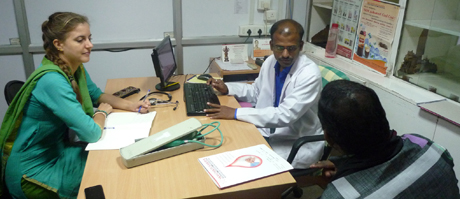Navigation auf uzh.ch
Navigation auf uzh.ch
The author describes her journey through South India driven by an interest in how religious organizations and Siddha medicine interact with each other.
Nina Rageth
Traveling to Chennai, Madurai, Coimbatore, Salem, Erode, Pothencode; staying at Hotel Ajantha, Tamil Nadu Tourist Home, Lakshmi Bhavan, Murugeshan Homestay, Periyar Bungalow; eating in Annapurna, Durbar Mess, Bazar In, West Salai, Sri Sabari; improving my packing skills, acquiring expert knowledge on reading bus timetables and sharpening my flair for tracking down Xerox shops, quiet reading enclaves and fancy ice-cream parlors; establishing a network of interlocutors, thinking about reciprocity between the observer and the observed, venerating the life of the traveling researcher and simultaneously experiencing the depth of the investigator’s loneliness. I am en route in South India for four months—generating material for my PhD by undertaking a multi-sited field study.

Multi-sited ethnography refers to a mode of ethnographic research which emerged in the 1980s and which has as its seminal text George Marcus’ piece “Ethnography in/of the World System: The Emergence of Multi-Sited Ethnography,” [1] published 1995. What characterizes this mode of research is that it “defines for itself an object of study that cannot be accounted for ethnographically by remaining focused on a single site of intensive investigation.” (96) Marcus speaks of a “mobile ethnography” that “takes unexpected trajectories in tracing a cultural formation across and within multiple sites of activity.” (96) Accordingly, multi-site fieldwork becomes an exercise in mapping the terrain of the object of study. And the fieldwork experience is heavily colored by the practices of following and tracing the research object through different settings; an object “that turns out to be contingent and malleable as one traces it.” (106) It is noteworthy that settings or sites are not only viewed as referring to bounded, geographical locations even though the spatial de-centeredness is a defining characteristic of the research mode. The multi-sitedness of this approach also lies in its accounting for different practices, actors and narratives. The researcher who applies a multi-sited approach follows the production of the object of her study in “several different locales,” (99) and constructs her research object based on different sources, material and perspectives.
Which route am I traveling? I follow the making of traditional Tamil medicine, which is Siddha medicine in the context of religious organizations in the two states Tamil Nadu and Kerala. Religious organizations constitute a single-site so to speak, a bounded framework for my study. Other locales like government institutions, private clinics, medical tourism or public discourses on health are left aside, even though they are relevant for the constitution of the wider medical field in which the research object is situated. Within this single frame I am tracing the production, distribution and popularization of traditional Tamil medicine through multiple sites: Firstly, I am looking at three religious organizations with different histories, organizational structures, resources at hand and agendas. And secondly, I am examining the intersection of the religious organizations and Siddha medicine in different locales: in the manufacturing units where herbs are boiled into thick herbal juices, minerals ground into fine powders and poisonous metals turned into highly-reactive medicine, at the moment of distribution of the medicine in the doctor-patient encounter in consultation rooms, mobile clinics and medical camps, and finally in discursive practices which attribute value and meaning to the medical knowledge and practice as well as the medicinal substances.
Travelling this route confronts me with multifarious situations and involves a broad range of activities, paces, challenges, frustrations and rewards. Multi-site fieldwork is an endeavor that, in my experience, best translates as viel-seitige Feldforschung.
[1] Marcus, George, “Ethnography in/of the World System: The Emergence of Multi-Sited Ethnography”, Annual Review of Anthropology 24, 95–117.
(Asia & Europe Bulletin, 5/2016, pp. 34–35)